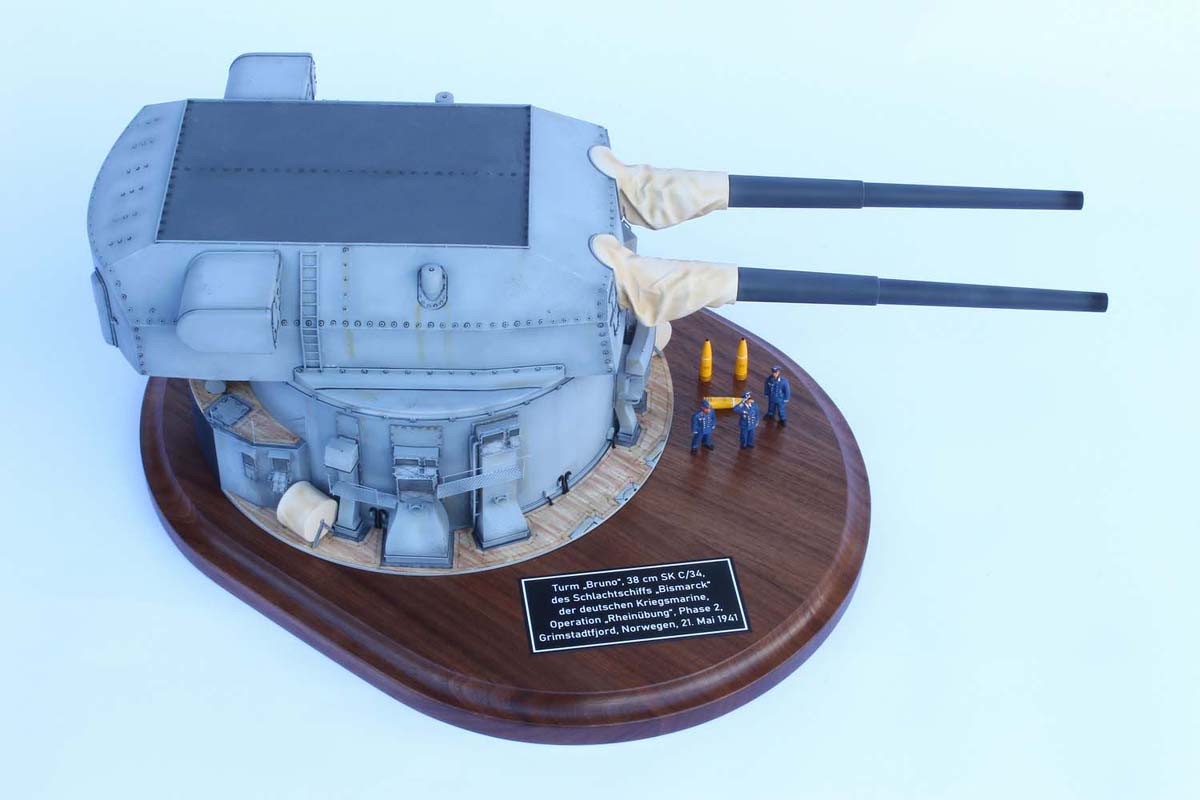
by Matthias Pohl |

History
The starting point for the development was the construction of the battleships of the Bismarck class, which were to be equipped with guns of the caliber 38 cm as the main armament. The performance data of the 38 cm SK L/45 gun model from the First World War were descended from the battleships SMS Bayern and SMS Baden, they did not complied with the requirements of the Kriegsmarine. Above all, the maximum barrel elevation of only 20° and the resulting comparatively low maximum firing range of 23,300 meters were considered as insufficient. In addition, the low altitude and lateral alignment speed of the gun were criticized. Friedrich Krupp AG Essen received the contract to develop a new fast-loading gun (SK means Schnellladekanone) in caliber 38 cm L/52 with a turret weight of 1052 t. The ammunition of the 38 cm SK C/34 is divided in projectile, pre-cartridge and sleeve cartridge, which has been loaded according to the target requirements. Loading the weapon required 2 attachments. In the first, the projectile was loaded. In the second, the two propellant components. Against heavily armored targets, the panzer explosive grenade was used, which can penetrate about 39 cm of armored steel over 20 km and detonate after penetration of the armour protection with ignition delay inside the target. The explosive grenades were used against light and unarmored targets, whereby the explosive grenade with ground fuse caused damage to the interior of the target due to the ignition delay.
In addition to the Bismarck and the Tirpitz, the 38 cm S.K.C/34 was also planned as armament for the battlecruisers of the O-Class. The planned conversion of the Gneisenau in 1942 was also to take place on this gun. Other guns had been sold to the Soviet Union, but they were never delivered. With the final decommissioning of the Gneisenau after the failed „Unternehmen Regenbogen“ („Operation Rainbow“) in 1942 and the abandonment of the O-Class, the original purpose of the already produced guns ceased to exist. A part was then installed as coastal guns in the so-called Atlantic Wall, for example in the Todt battery on the Pas de Calais, in the Hanstholm fortress in Denmark and in Kristiansand in Norway. Other examples were used as railway guns with the nickname "Siegfried".
(Source: Wikipedia)
My Model:
Recently, TAKOM published the turret "Bruno" of the battleship "Bismarck". As an enthusiast in the history of the German Navy, I absolutely had to have such an extraordinary model in my showcase! But even before the construction, my thoughts went in the direction how I would be able to present the turret the best way.
First there was the crazy idea to buy another "Bruno", to convert it into the tower "Anton", to add a larger wooden deck, to give the whole Dio a side panel with water surface, on which I also wanted to represent a watered Arado 196! However, the first sketches with the dimensions made this plan disappear very quickly – due to the limited space in my showcases.
Ok, then something different! In any case, the unspeakable round plastic base that TAKOM had placed underneath the "Bruno" had to be cut away. I absolutely didn't like it. I wanted a representation on a wooden base, even if it looks almost like a breakfast board. Roland Dörrich, the carpenter I trust, recommended walnut wood to me. He cut the pedestal from a massive piece of walnut wood.
In the online store with the four colorful letters, I came across a Chinese supplier from Shenzen (a manufacturer name cannot be deciphered, maybe it comes from "Three Flowers"), who offered a self-adhesive wooden deck, turned aluminum barrels and a whole swing of 38 cm grenades to match the "Bruno". I think the grenades and the pipes are a very useful extra. Especially with the gun barrels, you get rid of the tiring cleaning of the glue line – which is a real challenge at this length to present the barrel as one piece. The wooden deck, on the other hand, was really lousy, because of ist bad fitting. It had to be recut in many places, but then it fits! I tried to depict the weathering with diluted Vallejo paint. The construction of the "Bruno" itself took place oob, attaching the PE material was a little bit fiddly, especially the handrails.
The real incentive to me was the painting of the model. I did not want to depict the large areas of the tower "only gray". So: pre-shading with black, marbling with gray and dark gray, using a stencil, main paint glazing, filter, washing, dry painting with light gray. The covers of the rope drums and the blast bags got only a two shade painting – all was done with colors from the Vallejo’s colour range.+
The kit provides four painting options for the "Bruno". It was several times painted over during the „Operation Rheinübung“ ("Operation Rhine Exercise"). I decided to show the turret during the "Phase Two" with dark turret deck and dark barrels, as it was attached to "Bruno" on May 21, 1941 in the Grimstadtfjord in Norway.
To demonstrate the size comparison of my models, I like to use a representation with figures. Now there are a lot of figures of the German Kriegsmarine in the 72nd scale – but about 95% are figures of submarine crews! Finally I found a nicely moulded set from Hecker & Goros, who released three figures in usual clothing which was worn by members of the German Kriegsmarine. I also like the size comparison with the 38 cm grenades of the SK C/34 pretty mouch, it’s an impressive little extra in the overall presentation! The yellow coloring and the shape of the grenades mark them as explosive grenades. Armor-piercing shells were grey-green, but that was a little too dreary for me in my dio.
Hope you like it!
